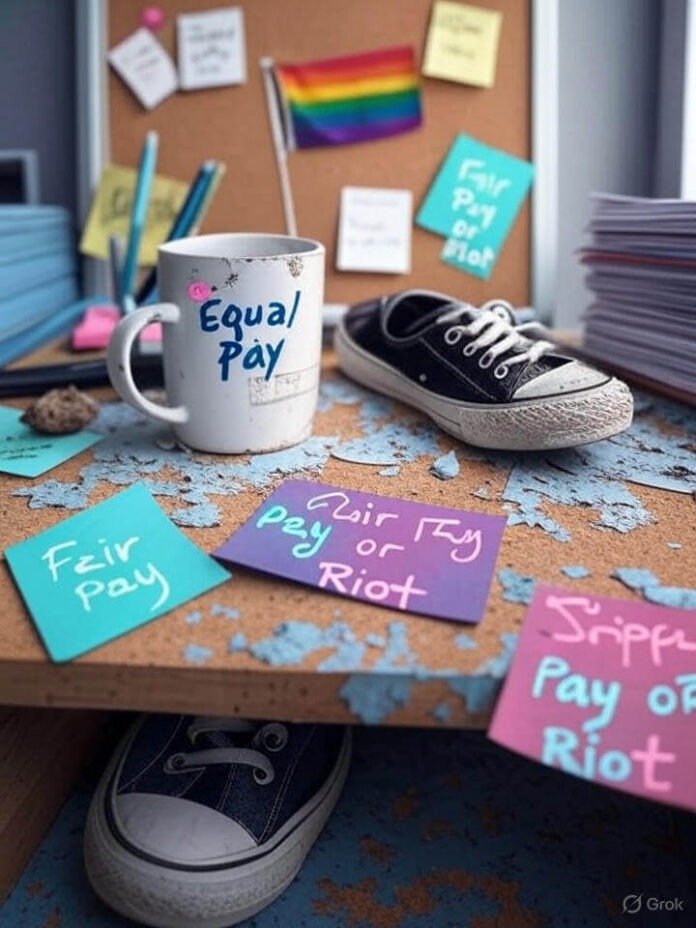Workplace equality is not some TikTok trend, it’s a freaking right. I’m typing this in my shoebox Brooklyn apartment, the AC wheezing like it’s got asthma, and I’m stuck on this one time I totally blew it at work. Fresh outta college, at this Manhattan startup, I overheard my coworker Jen got paid, like, way less than this dude Mike for the same dang job. Same grind, same stress, same gross coffee machine smell. I didn’t say squat—too nervous, too new. Still kicks me in the gut, that memory, like the bitter bodega coffee I’m chugging now.
Why Workplace Equality Keeps Me Awake
I’ve been in offices where “equality” was just a lame poster by the microwave. My last job? Total trainwreck. All glass walls and free granola bars, but the vibes were off. This one time, in a meeting, my boss—let’s call him Chad—cut off my coworker Priya to explain her project. I wanted to yell, “Yo, Chad, let her talk!” but my hands got sweaty, and I just froze. Priya said she was “used to it.” Used to it? That’s like getting used to a subway delay. Workplace equality means nobody should deal with that crap. I read this Harvard Business Review thing that’s got some real talk on inclusive workplaces—worth a look.
- It’s personal: Seen friends get skipped for promotions cause of their gender or accent. It ain’t “business”; it’s unfair.
- It’s messy: I’ve stayed quiet when I shoulda spoke up. Learning’s tough, yo.
- It’s urgent: Fair treatment ain’t a bonus—it’s the baseline.

Image Details: Feels like I’m sneaking a pic during a heated meeting, catching the raw energy of folks fighting to be heard. That shaking pen’s someone ready to snap but pushing through. Orange pop—maybe a folder or scarf—adds a spark of optimism.
Equal Workplace: My Big Oof Moments
Man, I’ve messed up. At that startup, I tried to play hero and set up a diversity workshop. Thought I was killing it. Nope. Total flop. Got this speaker who droned about “synergy” while everyone was on their phones, probably tweeting memes. My face was redder than a summer sunburn. But it hit me: workplace equity’s not about one big event. It’s the small stuff, like making sure quieter folks get heard or asking why the same dudes keep getting the cool projects. Found this McKinsey report that says inclusion actually makes companies better—good stuff.
Here’s what I’m trying now:
- Speak up. Even if my voice sounds like a squeaky toy.
- Listen for real. Not just nodding while I think of something witty.
- Own my fails. I’m a mess sometimes, and that’s okay.
Workplace Equity: Not Just “Woke” BS
Okay, some folks act like workplace equality’s just a buzzword, like “self-care” or whatever. Drives me bananas. Last week, I’m at this taco spot in Williamsburg, munching carnitas, and this guy next to me’s ranting about “equity” being “reverse discrimination.” I nearly choked on my tortilla. Wanted to argue, but my mouth was full, and I didn’t wanna look like a chipmunk. So here’s my take: inclusive workplaces ain’t about pity hires. It’s about everyone getting a fair shot. Done. Forbes has this article on how equity sparks innovation—check it out.

Image Details: Like I’m staring out the window after a crap day, lost in my head. The protest sign reflection’s subtle but bold. Gold glow—maybe a streetlight—adds a smidge of hope.
My Tips for a Fairer Workplace (From a Hot Mess)
I’m no expert, just a dude who’s learned the hard way. Wanna make work fairer? Start small. Notice who’s not talking in meetings or why the bosses all look like they’re from the same frat. I once suggested blind resumes to cut bias. Got some side-eye, but it helped—hiring got less sketchy. Don’t be scared to look dumb, either. I butchered a coworker’s name, asked how to say it right, and yeah, screwed it up again. But they laughed, said it meant something. SHRM’s guide has dope tips on inclusive habits.
Wrapping Up My Workplace Equality Rant
So, I’m on my saggy couch, my cat glaring like I owe her rent. Workplace equality’s not some glossy dream—it’s gritty, messy, and worth it. I’ve been too quiet, made dumb moves, but I’m trying, ya know? Drop your stories in the comments or on X—what’s one thing you’ve done to make work fairer? I’m all ears.





































